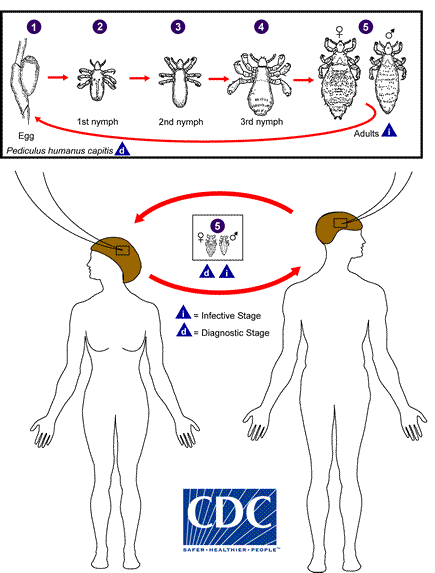Biology
Causal Agent:
Pediculus humanus capitis, the head louse, is an insect of the order Psocodea and is an ectoparasite whose only host are humans. The louse feeds on blood several times daily and resides close to the scalp to maintain its body temperature.
Life Cycle:

The life cycle of the head louse has three stages: egg, nymph, and adult.
Eggs: Nits are head lice eggs. They are hard to see and are often confused for dandruff or hair spray droplets. Nits are laid by the adult female and are cemented at the base of the hair shaft nearest the scalp ![]() . They are 0.8 mm by 0.3 mm, oval and usually yellow to white. Nits take about 1 week to hatch (range 6 to 9 days). Viable eggs are usually located within 6 mm of the scalp.
. They are 0.8 mm by 0.3 mm, oval and usually yellow to white. Nits take about 1 week to hatch (range 6 to 9 days). Viable eggs are usually located within 6 mm of the scalp.
Nymphs: The egg hatches to release a nymph ![]() . The nit shell then becomes a more visible dull yellow and remains attached to the hair shaft. The nymph looks like an adult head louse, but is about the size of a pinhead. Nymphs mature after three molts (
. The nit shell then becomes a more visible dull yellow and remains attached to the hair shaft. The nymph looks like an adult head louse, but is about the size of a pinhead. Nymphs mature after three molts (![]() ,
, ![]() ) and become adults about 7 days after hatching.
) and become adults about 7 days after hatching.
Adults: The adult louse is about the size of a sesame seed, has 6 legs (each with claws), and is tan to grayish-white ![]() . In persons with dark hair, the adult louse will appear darker. Females are usually larger than males and can lay up to 8 nits per day. Adult lice can live up to 30 days on a person’s head. To live, adult lice need to feed on blood several times daily. Without blood meals, the louse will die within 1 to 2 days off the host.
. In persons with dark hair, the adult louse will appear darker. Females are usually larger than males and can lay up to 8 nits per day. Adult lice can live up to 30 days on a person’s head. To live, adult lice need to feed on blood several times daily. Without blood meals, the louse will die within 1 to 2 days off the host.
Life cycle image and information courtesy of DPDx.
- Page last reviewed: September 2, 2015
- Page last updated: September 2, 2015
- Content source:


 ShareCompartir
ShareCompartir